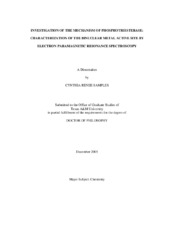| dc.contributor.advisor | DeRose, Victoria J. | |
| dc.creator | Samples, Cynthia Renee | |
| dc.date.accessioned | 2010-01-14T23:58:21Z | |
| dc.date.accessioned | 2010-01-16T02:23:01Z | |
| dc.date.available | 2010-01-14T23:58:21Z | |
| dc.date.available | 2010-01-16T02:23:01Z | |
| dc.date.created | 2005-12 | |
| dc.date.issued | 2009-05-15 | |
| dc.identifier.uri | https://hdl.handle.net/1969.1/ETD-TAMU-1010 | |
| dc.description.abstract | Phosphotriesterase (PTE) from Pseudomonas diminuta is a zinc metalloenzyme
found in soil bacteria capable of organophosphate hydrolysis at rates approaching the
diffusion controlled limit. Interest in PTE for degradation of chemical warfare agents and
disposal of pesticides supports the need to understand the mechanism by which it
performs hydrolysis. For further mechanistic clarity, this work will provide direct
confirmation of the solvent bridge identity and the protonated species resulting in loss of
catalytic identity. Inhibitor and product binding to the metal center will also be
addressed; as well as the evaluation of the catalytic activity of Fe(II)-substituted PTE.
This work has determined that the Mn/Mn-PTE electron paramagnetic resonance
(EPR) spectrum exhibits exchange coupling that is facilitated through a hydroxide bridge.
Protonation of the bridging hydroxide results in the loss of the exchange coupling
between the two divalent cations and the loss of catalytic activity. The reversible
protonation of the bridging hydroxide has an apparent pKa of 7.3 based upon changes in
the EPR spectrum of Mn/Mn-PTE with alterations in pH. The pH-rate profile for the
hydrolysis of paraoxon by Mn/Mn-PTE shows the requirement of a single function group
that must be unprotonated with a pKa of 7.1. The comparable pKa values are proposed to
result from the protonation of the same ionizable species.
The effects of inhibitor and product binding on the magnetic properties of the
metal center and the hydroxyl bridge are investigated by accessing new EPR spectral features. This work concludes that the binding of inhibitor occurs at the metal center and
results in an increase of non-bridged hydroxyl species. These results, in conjunction with
kinetic and crystallographic data, suggest that substrate binding via the phosphoryl
oxygen at the ?-metal weakens the hydroxyl bridge coordination to the ?-metal. This
loss of coordination would increase the nucleophilic character of the bridge, and binding
of the substrate to the metal center would result in a stronger nucleophile for hydrolysis.
Lastly, Fe(II) binding and activation of apoenzyme is evaluated under anaerobic
conditions. This work concludes Fe/Fe-PTE is not catalytically active, but can bind up to
2 equivalent Fe(II) ions per active site. | en |
| dc.format.medium | electronic | en |
| dc.format.mimetype | application/pdf | |
| dc.language.iso | en_US | |
| dc.subject | PTE | en |
| dc.subject | phosphotriesterase | en |
| dc.subject | manganese | en |
| dc.subject | EPR | en |
| dc.subject | enzymes | en |
| dc.subject | amidohydrolase superfamily | en |
| dc.subject | binuclear active site | en |
| dc.title | Investigation of the mechanism of phosphotriesterase: characterization of the binuclear metal active site by electron paramagnetic resonance spectroscopy | en |
| dc.type | Book | en |
| dc.type | Thesis | en |
| thesis.degree.department | Chemistry | en |
| thesis.degree.discipline | Chemistry | en |
| thesis.degree.grantor | Texas A&M University | en |
| thesis.degree.name | Doctor of Philosophy | en |
| thesis.degree.level | Doctoral | en |
| dc.contributor.committeeMember | Dunbar, Kim | |
| dc.contributor.committeeMember | Fitzpatrick, Paul | |
| dc.contributor.committeeMember | Raushel, Frank M. | |
| dc.type.genre | Electronic Dissertation | en |
| dc.type.material | text | en |
| dc.format.digitalOrigin | born digital | en |


